Rare wildlife 101
Quick: What rare plants are found in southwest Georgia’s Bacon County?
Or, what unique ecosystem has been documented in metro Atlanta’s DeKalb County?
For answers to these questions, or similar ones about the other 157 counties in the state, there is a one-stop source: the rare species and natural community data on the DNR Wildlife Resources Division website.
Included are 1,425 plants, animals and natural communities – such as the Piedmont mesic hardwood forests in DeKalb – documented by counties, two sizes of watersheds and “quarter quad” areas based on U.S. Geological Survey maps.
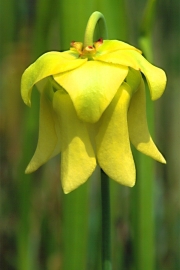 Information can be saved in different data formats, and sifted and sorted using spreadsheets and GIS software. (Tutorials explain how-to, including making a species range map.)
But if you just want to know what’s rare in your neck of the woods, click “County Rare Elements” and pick a county. The protection status of each species is listed, along with links to related animal and plant profiles.
Bacon County, for example, is home to bearded beaksedge, white sunnybell, rosy spiderwort and two state-protected plant species, yellow flytrap (left) and parrot pitcherplant.
"The clickable maps are designed for the non-tech savvy,” said Greg Krakow, conservation data manager for Wildlife Resources’ Nongame Conservation Section.
Krakow said the Nongame Conservation Section records where rare animal and plant species and natural communities are documented in Georgia. That information is logged, along with any state protections for a species, and shared with NatureServe, a data conservation network covering North America, Latin America and the Caribbean. NatureServe, of which Georgia DNR is a member, monitors national and international rankings for how rare a species is, plus name changes and other taxonomic updates.
The caveat: Databases cover only known occurrences. Also, NatureServe and county listing updates are in the works. But the CSV files posted, from which county data can also be pulled, were updated last month.
The net result is the best information at a glance or in-depth on Georgia’s rare wildlife and ecosystems.
|
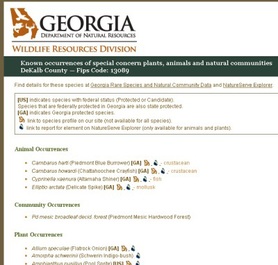
Data details
Number of tracked and protected species in Georgia represented in DNR conservation databases.
- Tracked: 489 animal species, 733 plant species, 203 natural communities.
- Protected: 165 animal species, 155 plant species
|
Rare wildlife 101: the series
This is the first in a three-part series on educational conservation information and efforts. We hope readers, including science teachers and students, find it helpful.
For Part II, in the next newsletter issue we’ll join Dr. Mincy Moffett and Anna Yellin of the Nongame Conservation Section for a broader look at resources and research tools. Part III will explore citizen science opportunities.
Comments? Please email us.
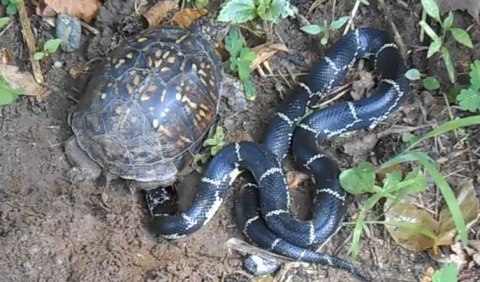 Showdown at Gwinnett park
Terry Trammell knew what he was watching at a Gwinnett County park was a wildlife interaction few had ever witnessed.
So he videoed it – providing amazing footage of a kingsnake interested in eating just-laid box turtle eggs even as the turtle tried to cover them up.
Trammell, a construction manager with Gwinnett County, was checking a stream restoration project at Lilburn City Park this month when he spotted the reptilian rumble near a walking trail.
Although first unsure what was happening, Trammell writes that he “soon figured out that the turtle had laid her eggs and while trying to cover them up the kingsnake was working to get to them for a meal.”
“… At times I was maybe a foot away with my camera but they both were so involved with what they were doing they never knew I was there or at least didn’t care.”
The video – watch part of it here! – shows the eastern kingsnake finally poking its head into the hole where the eggs where. Trammell says he saw it eat only two eggs.
The avid outdoorsman and licensed nuisance wildlife trapper writes that he monitored the animals so that no one walking by would try to harm the snake, a species protected by state law. He also explained what was going on and how unique it was to some people who stopped to ask.
Once the eastern box turtle had the eggs covered, Trammell moved it and the snake away. “Approximately 30 minutes later,” he writes, “the snake was back but was unable to get down to the eggs.”
While kingsnakes prey on birds, rodents, lizards and other snakes, turtle eggs are a favorite food. However, having the opportunity to see one pursue eggs while the turtle is trying to finish laying them is “pretty incredible,” said DNR wildlife biologist Thomas Floyd.
"It’s one of those things where you have to be in the right place at the right time.”
For another herp highlight this year, see “Rare river frog event in Lee County” (June 12 Georgia Wild).
Noteworthy
Loggerhead sea turtles have again topped 2,000 nests on the
Georgia coast! As of Friday, the total was 2,054, fewer than last year’s
25-year record of 2,241 but more than the previous high – 1,992 set in 2011. Updates at seaturtle.org.
Got a sec? We need your thoughts on Georgia Wild. If you haven’t
already, please take this brief survey. It’ll help us keep you better informed
about nongame conservation across our state.
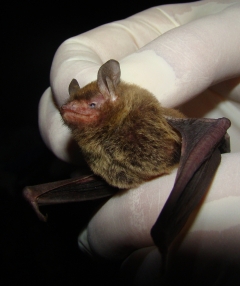 Bat pups are testing their wings, and sometimes finding them wanting. Learn more, and watch thermal camera video of bats leaving a Georgia cave, in this blog post by DNR biologist Trina Morris.
Gopher tortoise strategies for conserving this keystone species were a key focus at the annual Gopher Tortoise Candidate Conservation Agreement Team meeting, held this month at Charlie Elliott Wildlife Center. The agreement banks on proactive conservation among partners varying from the U.S. Forest Service to four state natural resource agencies and the Joseph W. Jones Ecological Research Center.
Swallow-tailed kite sightings in north Georgia, where the birds are rare but sometimes seen in summer, have been lighting up forums such as Georgia Birders Online and eBird. These graceful fliers have been seen soaring near Athens, Watkinsville and Mansfield, near Charlie Elliott Wildlife Center.
Georgia’s Stream Crossing Handbook, which is now available, recommends ways to improve fish passage at stream culverts. Road crossings often fragment stream habitat, undermining fish populations and diversity. U.S. Fish and Wildlife Service staff and DNR aquatic zoologist Dr. Brett Albanese wrote the handbook.
|
 Book it: The 26th annual Weekend for Wildlife, a vital fundraiser for nongame conservation in Georgia, is set for Jan. 31-Feb. 1 at Sea Island. Details.
The wild ginseng harvest reported by Georgia dealers topped 361 pounds dry weight, besting the 10-year average of nearly 286 pounds. Dealers paid an average price of $520 a pound.
Keeping bird feeders clean in summer is a challenge. It’s also critical, with heat and rain spurring bacteria and disease at our backyard bird “restaurants.” Try these cleaning tips.
Designating terrestrial critical habitat for the northwest Atlantic population of loggerhead sea turtles in six Southeastern states, including Georgia, will cost approximately $1.2 million over 10 years. That’s the cost of administrative efforts, 84 percent of which will be borne by federal agencies, says the U.S. Fish and Wildlife Service. Public comment on the proposal and the draft economic analysis has been reopened through Sept. 16.
While boating season always keeps DNR rangers busy, Cpl. Chris Ridley encountered a not-too-common violation June 9 in Jekyll Creek when he saw a boater feeding a bottlenose dolphin, which is illegal. Ridley cited the person under the federal Marine Mammal Protection Act of 1972. Law Enforcement Division reports. "Don't feed wild dolphins" video.
|
Headlines
(+video) "Fish art contest winners announced," 13WMAZ-TV (Macon)
(+video) "Man frees whale from fishing gear off Virginia Beach," The Virginian-Pilot
"DNR offers $1,000 grant for exceptional conservation teacher," NorthFulton.com
"Operation Easter, the hunt for illegal egg collectors," The New Yorker
"Are North Atlantic right whales mating in the Gulf of Maine?" NOAA Fisheries Service
"Spring rains spread wood-stork nesting," Coastalcourier.com
"8 Puerto Ricans face federal charges of illegally trading endangered sea turtles," The Washington Post
"Dolphins 'call each other by name,'" BBC
"Gates open at first state park on Lake Lanier," AccessNorthGeorgia.com
"Awards honor conservation proponents" including N.C. Wildlife Resources Commission for work in Operation Something Bruin with Georgia DNR and other agencies, News & Observer (Raleigh, N.C.)
"Just hanging on: Why mussels are so good at it," Massachusetts Institute of Technology
Parting shot
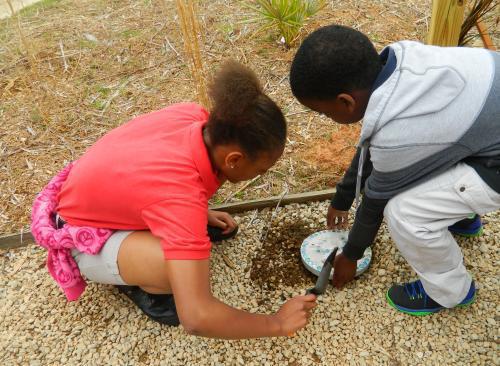 (Editor's note: This photo was inadvertently left out of the July 12 issue.)
Students at Fowler Drive Elementary in Athens install stepping stones at the school’s
"coastal” garden recently. The garden, which features plants native to the Georgia coast, is
part of a project that earned science teacher Halley Page a $1,000 grant from DNR’s Nongame
Conservation Section and its friends group, The Environmental Resources Network. Nongame
and TERN are looking for another Georgia third-, fourth- or fifth-grade teacher who demonstrates
exceptional energy and innovation in teaching life sciences and could use $1,000 toward that effort.
The deadline to apply is Sept. 16. Review details and download a grant application. Read the news release. Learn more about TERN.
Credits
** Masthead: swallow-tailed kite. Todd Schneider/Ga. DNR
** Yellow flytrap
** Kingsnake and box turtle. Terry Trammell
** Southeastern bat. Trina Morris/Ga. DNR
** Fowler Drive Elementary students at work in the school's coastal garden. Linda May/Ga. DNR
.
 Give wildlife a chance!
The Nongame Conservation Section of Georgia DNR receives no state funds to conserve nongame wildlife, native plants and natural habitats. Instead, we depend on contributions, grants and fundraisers, such as the eagle and hummingbird license plates.
How can you help?
|
|